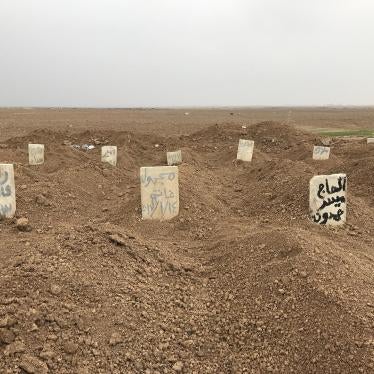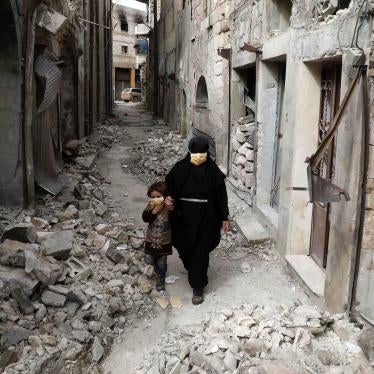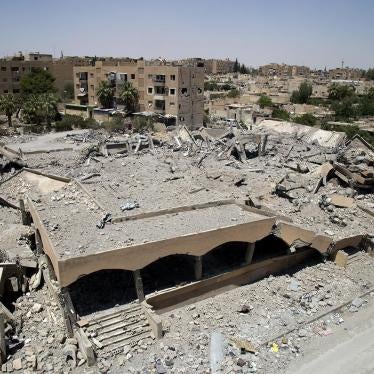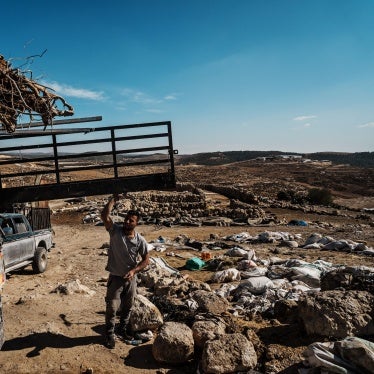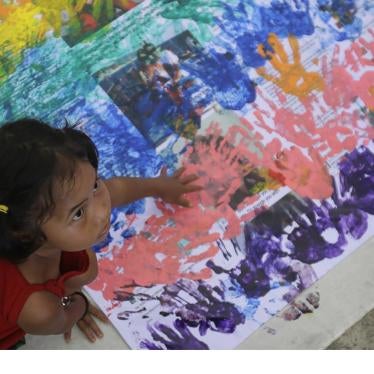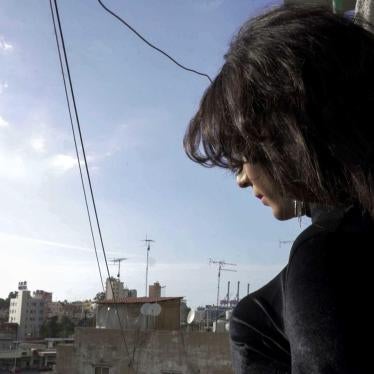(Beirut) – The civilian death toll from a series of apparent Iraqi Security Force or United States-led coalition attacks between February and April 2017 suggests that the forces took inadequate precautions to avoid civilian casualties and that further investigation is needed, Human Rights Watch said today. Human Rights Watch documented seven attacks that resulted in at least 44 civilian deaths in five populated neighborhoods of west Mosul controlled by the Islamic State (also known as ISIS).
Human Rights Watch analysis of satellite imagery of western Mosul identified over 380 distinct impact sites in the Tanak neighborhood, where three of the seven attacks occurred, consistent with the detonation of large, air-dropped munitions between March 8 and April 26, when Iraqi forces declared they had regained control of the area. Munitions of this size can pose an excessive risk to civilians when used in populated areas, given their large blast and fragmentation radius. All warring parties should cease using explosive weapons with wide area effects in densely populated west Mosul.
“Residents and displaced people have sheltered for months in crowded houses, with ISIS sometimes using them as human shields, so any strikes – including the choice of weapons – should take these conditions into account,” said Priyanka Motaparthy, senior emergencies researcher at Human Rights Watch. “As Iraqi and coalition forces press forward with the west Mosul offensive, they should make sure that civilian casualties are kept to a minimum.”
A US airstrike in Mosul on March 17 that killed up to 200 people, previously documented by Human Rights Watch, used a 500-pound bomb to target two ISIS fighters on a roof, according to a military investigation of the incident.
Anti-ISIS forces should take all feasible precautions in the choice of means and methods of warfare to minimize incidental loss of civilian life, injury to civilians, and damage to civilian objects, including in their choice of weaponry in heavily populated areas, Human Rights Watch said.
Human Rights Watch also documented six incidents in which ISIS fighters shot at and killed or wounded civilians fleeing ISIS-held areas or in which the people fleeing detonated improvised landmines laid by ISIS.
In mid-February, Iraqi Security Forces (ISF) supported by the US-led coalition, known as the Combined Joint Task Force – Operation Inherent Resolve (CJTF-OIR), began the offensive to retake west Mosul, a densely populated set of urban neighborhoods still home to around 200,000 civilians. At least 614,524 people have fled the area since February 19, 2017, according to Iraqi authorities, but thousands more remain trapped under deadly conditions, risking ISIS sniper fire and improvised landmines when they attempt to flee.
Human Rights Watch could not independently confirm whether the seven Iraqi forces or coalition attacks it documented were air or ground-launched, or identify the munitions. The locations were under ISIS control. ISIS fighters were present in or next to the homes destroyed right before or at the same time in three of the attacks, within 50 meters in two incidents, and were not in close proximity in two others, survivors and witnesses said.
At least two incidents with no clear military target in the vicinity that killed at least 13 civilians may have been unlawful. The remaining attacks may have caused disproportionate civilian harm in comparison to the military advantage gained, in violation of international humanitarian law.
Civilians living in each of the homes hit by the seven attacks said they had tried to leave the neighborhood, sometimes repeatedly, as fighting grew close to the area, but that ISIS fighters threatened to kill them or attacked them when they tried to leave.
All parties to the conflict are prohibited under the laws of war from conducting deliberate, indiscriminate, or disproportionate attacks against civilians or civilian objects. Indiscriminate attacks strike military objectives and civilians or civilian objects without distinction. An attack is disproportionate if it may be expected to cause incidental loss of civilian life or damage to civilian objects that would be excessive in relation to the concrete and direct military advantage anticipated from the attack.
Human Rights Watch contacted CJTF-OIR regarding the seven attacks. The coalition confirmed its forces most likely carried out one of the attacks, on the Mosul Railway Station neighborhood, killing 10 civilians, but did not respond definitively on the remaining incidents.
Human Rights Watch has previously raised concerns about individual coalition members’ targeting procedures. As a result of procedural changes made in December 2016, media reported the US, which leads the coalition, removed the requirement that the “strike cell” in Baghdad approve certain strikes. The rule change means that the US is now carrying out some strikes without the benefit of the strike cell’s information and targeting recommendations. The US should reinstate these procedures, or equivalent ones.
Human Rights Watch also remains concerned that the coalition reporting mechanism has failed to adequately reflect the extent of civilian casualties caused by members. On June 2, 2017, CJTF-OIR published its monthly civilian casualty report. The report found that, “To date, based on information available, CJTF-OIR assesses that, it is more likely than not, at least 484 civilians have been unintentionally killed by coalition strikes since the start of Operation Inherent Resolve.” During the same period, Airwars, a United Kingdom-based nongovernmental organization that monitors airstrikes, estimated that the minimum number of civilian casualties from US-led coalition strikes was over 3,800, approximately eight times the number reported by the coalition. US military officials have said that non-US coalition members are responsible for at least 80 of the 484 fatalities, but none of the coalition members have publicly admitted responsibility.
In addition to coalition reporting, each member country has an individual responsibility under international law to conduct thorough, prompt, and impartial investigations of alleged serious violations of international humanitarian law for strikes in which it has been involved. Coalition members vary in their documentation and investigation of civilian casualties.
Although the coalition now jointly conducts preliminary assessments of alleged civilian casualties, coalition members should not rely on other coalition members, or broader coalition reporting, to collect information or to assess whether a strike they have conducted complies with the law.
The coalition, member countries operating in the area, and Iraqi authorities should investigate their role in attacks reported to cause serious violations of international humanitarian law, including by interviewing survivors, and not just rely on self-reporting and/or battle damage assessments, Human Rights Watch said. Should there be evidence of war crimes – including serious violations of the laws of war committed with criminal intent – any perpetrator of the crime should be prosecuted, including any commander responsible under the principle of command responsibility.
The apparent lack of compensation to victims of coalition operations also remains a critical concern. A coalition spokesperson told Human Rights Watch that the coalition has only received two compensation requests, and has made two condolence payments since the beginning of Operation Inherent Resolve. Members of the coalition involved in military operations should take appropriate steps to verify civilian casualties, identify the victims, and deliver appropriate compensation in the case of violations of international law. Human Rights Watch also recommends appropriate “condolence” or ex gratia payments – those made without legal obligation – for civilian harm.
“Individual countries shouldn’t hide behind the coalition and wash their hands of responsibility,” Motaparthy said. “Coalition members should take responsibility for the strikes they carry out by investigating those that may have been serious violations, particularly given how inadequate coalition investigations have been.”
The Satellite Imagery
Human Rights Watch analyzed satellite imagery of the Tanak neighborhood, where three of the attacks documented took place, and identified over 380 distinct impact sites consistent with the detonation of large, air-dropped munitions between March 8 and April 26, 2017. A review of damaged locations showed that a majority of these airstrikes most likely targeted mixed residential and commercial buildings, with a substantial minority targeting main streets and intersections. Human Rights Watch has no information as to whether there were any military targets in or near the sites.
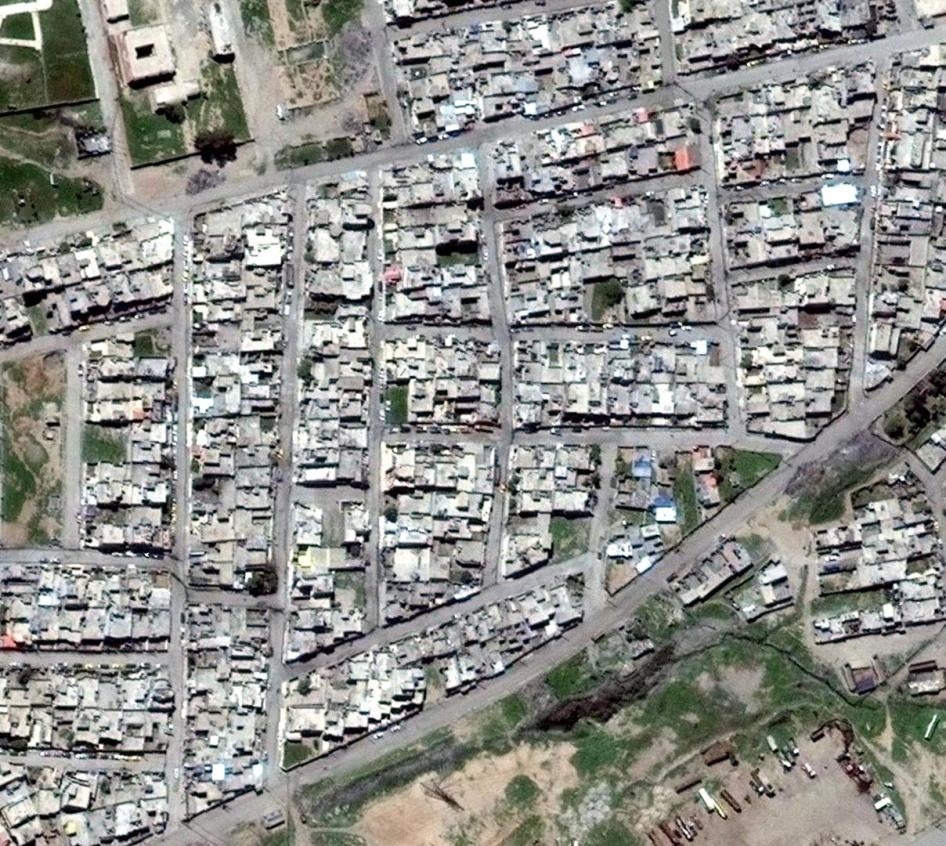
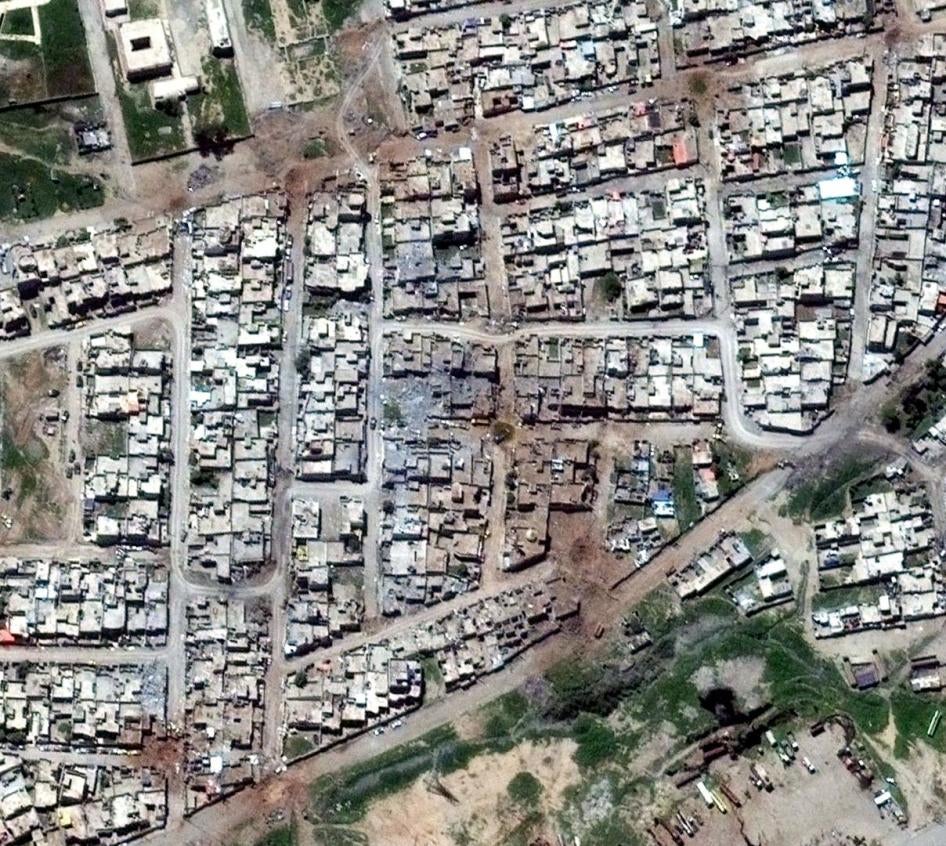
Before and after satellite imagery of Tanak neighborhood, Mosul April 10 and 26, 2017. Satellite imagery © DigitalGlobe 2017
Although this apparently accurate targeting pattern of the street network is consistent with the use of guided munitions, Human Rights Watch found that the majority of impact craters in Tanak measured 10 or more meters in diameter, consistent with the use of conventional air-dropped bombs weighing between 500 and 1,000 pounds.
The use of explosive weapons with wide-area effects such as air-dropped bombs of this size on probable military targets in densely populated civilian areas of western Mosul may be resulting in civilian casualties and damage to civilian objects that is excessive considering the anticipated military objectives of the strikes. Such disproportionate military attacks are prohibited under international humanitarian law. In all cases, commanders and targeting officers should select weapons and specific munitions to minimize civilian casualties to the maximum extent possible.
Attacks that Resulted in Civilian Casualties, West Mosul
|
Neighborhood |
Date and Time |
Object Struck |
Minimum Number of Civilians Killed |
ISIS Presence |
|
Risalah neighborhood |
February 22, 8:30 a.m. |
Home of Gargis Younes |
2 |
Vehicle parked behind the house. |
|
Mosul Railway Station area |
Between March 3-6, 5:50 p.m. |
Home |
10 |
None in home. |
|
Tanak neighborhood |
Early April |
Home, road |
3 |
Three ISIS fighters firing at ISF, about 200 meters from strike that killed 3. |
|
Sakkak neighborhood, Old City |
April 10, 1 p.m. |
Home |
13 |
None in home. One fighter stationed on roof next door. |
|
Thawra neighborhood |
April 22 |
Home |
Unknown |
Seven fighters passed through the house minutes before the attack. |
|
Tanak neighborhood |
Between April 20-24 |
Home of Aissa Hannoush |
13 |
ISIS fighting position in front of house. Four fighters passed through the house minutes before attack. |
|
Tanak neighborhood |
April 22 to 27 |
Two homes |
3 |
Five ISIS fighters 30 meters from one home, firing toward ISF position. |
Civilians living in each of the homes hit by the seven attacks said they had tried to leave the neighborhood, sometimes repeatedly, as fighting grew close, but that ISIS fighters threatened to kill them or attacked them when they tried to leave.
Risalah Neighborhood, February 22, 2017
On February 22, at approximately 8:30 a.m., an explosive weapon hit the home of Gargis Younes, about 50 meters southeast of the Medina al-Munawwara mosque, killing two of his young children and wounding two others. The neighborhood housed a significant civilian population that continued to move within the area. Younes’s sister, Najla Abdullah, said he was with her at her house, about 100 meters from his home, at the time.
Abdullah said she heard a plane overhead and shortly thereafter, a boy from the neighborhood came to her home and told them that Younes’s house had been hit. Alaa, Younes’s 10-year-old daughter, died immediately, while his 4-year-old son died later from his injuries. Thanoon, his 8-year-old son, and Rahma, his 6-year-old daughter, were injured but survived, and his wife was unharmed. Abdullah said:
My brother went to see his house. I stayed behind. First, they [people from the area] brought Alaa, his daughter, then the smallest child who died later, Younes. They [the wounded children] stayed with us until 4 p.m. We couldn’t go out, even to take them to the hospital.
The neighborhood was under ISIS control at the time of the attack, Abdullah said. Fighters were present throughout the area and had parked one of their cars behind Younes’s house, but Abdullah did not hear them firing weapons the morning of the attack, she said. Her brother noticed the car on the way to her house that morning, 30 minutes before the strike, she said.
The neighborhood continued to house a significant civilian population. Abdullah’s family, and her brother’s, had been living in the area continuously, reflecting that the force that carried out the attack should have been able to observe the civilian presence in the area through surveillance. The attack occurred during the ISF operation to regain control of the area, Abdullah said. Due to heavy fighting that day, the family could not take the injured children to the hospital until that evening.
A local media source reported heavy airstrikes in seven west Mosul neighborhoods, including Risalah, days before on February 20, stating that the airstrikes “kill[ed] over two dozen ISIS militants, and destroy[ed] three VBIEDs, three mortar positions and four rocket positions.”
Human Rights Watch requested information from CJTF-OIR on whether the coalition had conducted airstrikes in the area, and received the following response: “We could not find a previous allegation or a coalition strike that correlates to this date and location. However, we will take this information and conduct a more thorough assessment on this allegation.”
Human Rights Watch was not able to determine whether ISIS fighters had been killed in this attack, or their firing position destroyed, as Abdullah did not visit the strike site after the attack.
Mosul Railway Station Area, March 3, 2017
At around 5:50 p.m. on March 3, three attacks killed at least 10 civilians including at least three children, in three homes near the Mosul Railway Station. The attacks appear to have been coalition airstrikes, based on the coalition’s public reporting.
Amr Sultan, 27, said that ISIS fighters were present throughout the neighborhood the day of the attack and that multiple car bombs had gone off in the area during the preceding weeks. He said he and eight members of his family had taken shelter in an abandoned one-story house several months earlier, after fleeing fighting in their area. Several other families had sought shelter in other houses in the same row. He said no ISIS fighters were in the house he was living in when it was hit and that Iraqi forces were stationed 700-800 meters away.
Sultan said he heard the sound of multiple aircrafts that day. He believed the house was hit by an airstrike because he heard planes flying low overhead, and because of the extent of the damage. The 250-square-meter house was completely destroyed, he said. The attack was one of three strikes on the row of homes.
When we were eating dinner, the plane struck. Next door was struck first, then us, then our neighbors on the other side. There was just a second between the strikes.
Of the nine people in the house, he said, five died: Aisha, his mother, 50; Abeer, his sister, 23; Hadeel, his sister, 17; Farah, his daughter, 4; and Ayham, his son, 3. Amr was severely burned on his head and ear, and his wife and two brothers were also injured, he said:
We spent one hour waiting for help. Some of the people – my sister, the children – died from suffocation [under the rubble]. We buried the bodies the next day.
Five civilians in the house next door died as well, he said. Amr helped bury the bodies. He did not know if any ISIS fighters had been killed. He and his family members had tried to escape the area a week earlier, as the fighting grew closer, but ISIS fighters told them they were not allowed to leave, he said.
Based on an inquiry Human Rights Watch sent to the US-led coalition, a CJTF-OIR spokesperson stated, “it appears this allegation correlates to a credible report of civilian casualties near a train station released in the last CJTF-OIR Monthly Civilian Casualty Report.” The report states that on “March 3, 2017, near Mosul, Iraq, via self-report: During a strike on an ISIS headquarters, it was assessed that 10 civilians were unintentionally killed.”
Al Jazeera, citing unnamed security sources, reported that coalition airstrikes in the same neighborhood killed 28 people, including eight ISIS fighters, on the evening of March 5.
The coalition, any member country operating in the area, and Iraqi authorities, should investigate the attack, which may have been unlawful given the number of civilian casualties, and the apparent absence of ISIS fighters or positions in the immediate vicinity. The presence of several civilian families in the area, some of whom had been living there for months or weeks, should have been evident from pre-strike surveillance. If no wrongdoing is found, the country responsible for the attack should consider condolence payments to civilian victims, including members of the Sultan family. Should there be evidence of war crimes – including serious violations of the law of war committed with criminal intent – any perpetrator of the crime should be prosecuted, including any commander responsible under the principle of command responsibility.
Tanak Neighborhood, Early April 2017
Saddam Hussein, 18, from west Mosul, said that in early April, at around 8 p.m., he was praying at his home in the Tanak neighborhood, when he heard aircraft overhead. He heard the sound of two munitions detonating, one of which hit the home opposite, and the other the road about 150 meters from his house, leaving a crater but not affecting any home or wounding anyone.
The home that was hit, a single-story house of three rooms and about 150 square meters, was completely destroyed when the munition landed in the kitchen, where some of the 20 members of the family were gathered. Three died, including two children. No fighters were in the home at the time, Hussein said:
I heard the screams of women and children and my father ran into my room and told me we needed to go help them. I told him we should wait, to be sure a third strike would not hit, before we went outside. After waiting a bit, we went over, and with the help of our neighbors pulled out two girls and two boys who were still alive because they had not been in the kitchen. I pulled out another boy, 3 years old, and when I opened his shirt, all of his organs spilled out and he died.
They pulled out the body of the father of the family, who was missing his head and one of his arms, as well as the body of a baby. Hussein said the front line between ISIS and the Iraqi forces was about 200 meters away and that he had seen at least three ISIS fighters firing at the Iraqi forces from their position there. The strike on the road landed about 50 meters from their position, he estimated.
Human Rights Watch requested information from CJTF-OIR on whether the coalition had conducted airstrikes in the area. A CJTF-OIR spokesperson stated the coalition could neither confirm nor deny participation in the attack due to the lack of a more specific date range.
Sakkak Nighborhood, Old City, April 10, 2017
An attack against ISIS killed 13 civilians from five families on April 10, in the Sakkak neighborhood, west of the Old City in west Mosul.
Iyad, 40, a shopkeeper, said that on the morning of April 10, Sakkak neighborhood, which was heavily populated by civilians at the time, was still under ISIS control. He was in his house, a single-story building of about 200 square meters.
He said the family of his next-door neighbor, Waleed Abu Nour, came to his house to seek refuge that morning because they had seen an ISIS fighter with a gun on their roof. He brought two other families who had been staying with him for several days, waiting for an opportunity to escape ISIS control. Iyad’s brother’s family was there as well. In all, about 32 civilians were in Iyad’s home.
At about 1 p.m. as the families were finishing lunch, they started hearing heavier fire nearby, he said:
I ran to hide under the stairs as I started hearing an airplane overhead in addition to the gunfire. Suddenly a huge explosion threw my back against the wall. I crawled out of a pile of rubble as I started to hear screams all around me. I could not see anything though because of all the dust in the air. Finally, the air cleared a bit and us men started carrying the 12 women and children who survived out to a house down the road from us. We could not get the dead out immediately though, there was gunfire all around us so we quickly fled back to the house down the road.
The munition landed between Iyad’s small shop and the room where all the women stayed. Iyad’s hands were wounded, but he and the other survivors, some of whom were lightly wounded, did not go to the hospital.
Iyad said that he could hear Iraqi forces a few hundred meters away at the time of the attack. Iyad’s mother and 5-year-old daughter died in the attack. Abu Nour’s wife and two sons and the wife and daughter of one of the visiting families died. Iyad’s brother as well as his brother’s wife and four children died. Only one of his brother’s sons survived.
Iyad said there were no ISIS fighters in his home at the time of the strike, nor any wounded or killed in the attack. He said that his neighbor’s house, where the ISIS fighter had been stationed on the roof, was barely damaged. Three adjacent houses were lightly damaged.
Iyad and his relatives returned to the site three days later, after seeking refuge in another neighborhood under Iraqi forces’ control, and saw that the area was fully under Iraqi forces’ control. They buried the bodies at a local cemetery.
An Iraqi military officer in the neighborhood at the time of the attack told a media outlet that an airstrike on April 10 in neighboring Yarmouk area targeted ISIS fighters on the roofs of civilian homes, destroying two buildings, and burying an estimated 30 civilians under the rubble. An April 16 report by the Iraqi Observatory for Human Rights also documented the attack in Yarmouk.
In response to a Human Rights Watch request for information on the attack and confirmation of whether the coalition was responsible, CJTF-OIR responded, “We are aware of reports of possible civilian casualties in West Mosul on April 17. The Coalition conducted a strike near Yarmouk but cannot confirm the veracity of these reports. We will provide this information to our civilian casualty team for further assessment.”
Thawra Neighborhood, April 22, 2017
An attack on a civilian house sheltering 90 people in the ISIS-held Thawra neighborhood of west Mosul trapped 88 of them under rubble. Many were injured or killed.
Nada Natham, 27, said that she, her husband, and her three young children were living in the two-room, single-story house along with several other families. Her family had fled Mosul’s old city to a relative’s house in the Thawra neighborhood, about two weeks earlier. She said that ISIS fighters came to the house three to four days before the attack and that seven of them stationed themselves on the roof, using passageways they created by breaking the walls of the house and the neighboring houses to move around. The fighters came into the house and told families they were not allowed to go toward Iraqi positions, though they wanted to leave the area, she said.
On April 22, she said, the ISIS fighters spent about two hours on the roof, then came down through the house. The house was struck soon after:
We heard the sound of airplanes. We were on the ground covering our ears, we were frightened. The women were in one room, men in the other room.
The bomb hit the entrance to the yard. The house fell down. First me and Mojbal [the other uninjured person] went outside and tried to help the others. We couldn’t, so we shouted and neighbors came to help. They used shovels to dig people out of the rubble.
Natham’s husband’s back was broken and her three young children, ages 5, 8, and 9, were injured. Natham did not see that any ISIS fighters were killed or wounded. Forces carrying out the attack should have been able to observe the presence of civilians in the house for at least two weeks before the attack.
Human Rights Watch could not independently confirm the incident was an airstrike. According to a local media source, Iraqi forces had declared Thawra neighborhood liberated that day. Two Federal Police officers told the media outlet that the Rapid Response Division, a force under the command of the Interior Ministry, and the 3rd and 5th divisions of the Federal Police, also under the Interior Ministry, had carried out the operation with close air support.
In response to a Human Rights Watch query on the incident, CJTF-OIR responded: “We could not find a previous allegation or a Coalition strike that correlates to this date and location. However, we will take this information and conduct a more thorough assessment on this allegation.”
Tanak Neighborhood, April 20, 2017
An attack against ISIS targeted the home of Aissa Hannoush, a well-known resident in the area, on April 20, at about 6 p.m. Twenty-eight people lived in the house; the strike killed 13 and injured the others. The home wasabout 50 meters west of the Daham Ismail mosque in the Tanak neighborhood of west Mosul. Two survivors, as well as two people living on the same street, described the attack as an airstrike.
Hadi Fathy, 26, who lived about five or six houses away, said he saw ISIS fighters park a minibus in front of the house and hide behind the vehicle while firing small arms and light weapons at Iraqi forces positioned at the other end of the block. His father, standing at the door of the house, which stood between the two forces, told him that two or three ISIS fighters had entered the home before it was struck, but he did not see them himself.
Khodar Allo and his wife Rafat Attiya, along with their family and other displaced families, were staying in the home of Hannoush, who was their neighbor. The house was sheltering four families, including Omar Hannoush, Aissa Hannoush’s son, and his family; the Allo family; and another family who lived on the street but felt the Hannoush home was more secure than their own due to its size and position. At around 3:30 p.m., two munitions hit the house. Allo said:
A rocket came to the living room and I was in that room, but the first one didn’t explode. It made a “zzzzz” sound, and after five minutes it exploded. Then another one came. The second rocket hit the women’s room.
Attiya said that four ISIS fighters had come through the house just a few minutes before the strike. Fighters demanded entry through the front door, then passed through an opening they had broken in the back, which allowed them to move to neighboring houses. They were gone by the time the strike hit. She said that the second munition, which hit the room where she and other women were staying, also did not explode for a few minutes. “[The weapon] made a hole, half was above and half was below,” she said. Both survivors said that after the munitions struck, the house fell down around them. Attiya said six people died in the neighboring home as well.
The Hannoush home was a one-story house of five rooms, about 450 square meters. Allo had severe burns all over his body, while his wife had fragmentation injuries and burns; their daughter, Amal Khadar, 25, and grandson Anis Haikal, 15, were among those who died.
The family had tried to leave the area three times, but ISIS fighters prevented them, Attiya said: “We tried leaving by night. ISIS saw us each time, and told us to go back.”
Saleh al-Rahim lived on the same street. After the bombing, he said, his own family remained in their house:
We couldn’t go out, because of the heavy fighting. Around maghreb[sunset prayer], we heard the sound of people shouting and crying for help. It was about 100 meters away.
The next day, at about 6 a.m., he and other people in the neighborhood went to rescue any survivors and retrieve the bodies. “We could still hear people shouting from the rubble, ‘Please help us!’” he said.
They retrieved Omar Hannoush, 22, who was burned all over his body and later died, and Ghazwan, a neighbor, 22, who died of his injuries at 6 p.m. that day. Fathy and other neighborhood residents buried 13 bodies in a neighbor’s yard. They could not go to the graveyard, he said, because of the continued fighting.
In response to a Human Rights Watch query on this incident, the press desk of the CJTF-OIR responded: “We could not find a previous allegation or a Coalition strike that correlates to this date and location. However, we will take this information and conduct a more thorough assessment on this allegation.”
Human Rights Watch found that the attack may have been unlawful, due to the number of civilian casualties, and the lack of evidence any ISIS fighters had been killed in the attack. Any attack should have anticipated civilian casualties, based on surveillance, since the Hannoush family had continuously occupied the house, and additional families continued to move in between a few weeks and several days before the strike. Several other houses on the street were continuously occupied by civilians. The coalition, any member country operating in the area at the time, and Iraqi authorities should further investigate and if no wrongdoing is found, the country responsible for the attack should consider condolence payments to civilian victims and their families. Should there be evidence of war crimes – including serious violations of the law of war committed with criminal intent – any perpetrator of the crime should be prosecuted, including any commander responsible under the principle of command responsibility.
Tanak Neighborhood, Between April 22 and 27
Mawza Thanoon, 46, from the Tanak neighborhood, said that in late April, her neighborhood was still fully under ISIS control and still heavily populated, with Iraqi forces holding a position about 600 meters away, from what she and neighbors could determine from ongoing shooting. At about 1 p.m., she started to hear aircraft overhead and suddenly a munition hit the front of her home, collapsing it. A few minutes later, another munition hit the front portion of another single-story home about 20 meters away.
Thanoon was uninjured, and no one else was at home, but the other strike killed two children and a young man, and wounded another, all of whom had been standing on the street outside. Immediately before the strike, she had seen at least five ISIS fighters about 30 meters from her home, firing in the direction of Iraqi positions. She said that airstrikes had been targeting the area daily for a month. The attacking forces should have observed civilians in the area, given the presence of civilians who had been continuously living in the area.
In response to a Human Rights Watch request for information on the attack and confirmation of whether the coalition was responsible, CJTF-OIR responded that the coalition did not conduct airstrikes in the Tanak area during that period.
ISIS Use of Civilians as Human Shields
Human Rights Watch found that ISIS used civilians as human shields in this phase of the fighting in Mosul, using the presence of civilians to make their forces, or a particular area, immune from military operations. Fighters positioned themselves on the roofs or in front of houses where civilians had sought shelter.
Furthermore, ISIS fighters forbade civilians from leaving front-line neighborhoods, and attacked civilians who tried to escape, killing some. This may have been because they intended to use the civilians as human shields, but in any event, this violates their duty to remove civilians under their control from the vicinity of possible military targets.
Abdullah Saleh, 35, who fled Tanak neighborhood in early April, said his son was killed by ISIS gunfire as they tried to escape, along with 20 other families. “An ISIS fighter was chasing us and shooting,” he said. “My wife told me, ‘I feel something hot on my shoulder.’ She was carrying our 2-month-old baby. When I looked, I saw our child had been shot in his head, and blood was coming down. I just told her to keep going.” A woman in her 40s fleeing from Tanak in a group of 50 to 60 families said that an explosive munition that came from the direction of ISIS-controlled territory struck their group, killing three and injuring at least 15, including her three children.
Fatouma Ismail, another west Mosul resident, said that when she fled al-Islah al-Zerai neighborhood days before the Iraqi forces retook it, her two nephews carrying her two daughters stepped on an improvised landmine. One nephew lost both of his legs, the other lost one leg, and the girls were injured. The devices were emplaced in ISIS-controlled areas, and are consistent with a pattern Human Rights Watch previously documented of ISIS using such improvised landmines.
The laws of war apply to all sides in the fighting in Iraq, including ISIS, which should remove civilians under their control from the vicinity of possible military targets, including their own fighters. Using civilians as human shields is a war crime.



